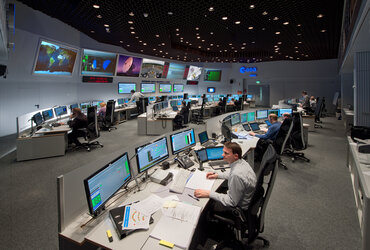ESA hands over weather satellite for operations
Since the launch of MSG-3, ESA’s mission controllers have been working to ensure that this latest weather satellite’s voyage to 36 000 km above the Equator runs smoothly. With MSG-3 healthy and now in its place of work, ESA has handed operations over to Eumetsat.
The third Meteosat Second Generation satellite took to the skies on an Ariane 5 rocket on 5 July from Europe’s Spaceport in Kourou, French Guiana.
Once fully operational, it will deliver essential information from geostationary orbit to monitor the weather over Europe, Africa and parts of the Atlantic and Indian Oceans.
ESA is responsible for developing the series of satellites and performing the critical Launch and Early Orbit Phase (LEOP) on behalf of Eumetsat, the European Organisation for Exploitation of Meteorological Satellites, who then commission the payload and carry out routine operations.
The 11-day LEOP has involved several critical tasks for the team at ESA’s European Space Operations Centre in Darmstadt, Germany.

The mission controllers have completed four engine burns to put the satellite in the correct orbit. These consumed almost 800 kg of propellants, about 80% of the total available.
As a result, the satellite is nearly in its geostationary orbit, drifting slowly east toward its final orbit position.
In addition, the meteorological instrument covers have been released, safely outside geostationary orbit. The instrument has been heated to drive off any contaminants and water vapour from the sensitive surfaces.
ESA’s MSG-3 Spacecraft Operations Manager, Chris Watson, said, “This is the third MSG we have launched, so you could say that we are familiar with the behaviour of the spacecraft.

“Nonetheless, MSG-3 managed to find a few minor surprises for us.
“Overall, though, this early phase has been extremely smooth and we are happy that this resource for weather forecasting has been brought safely to its place of work.”
Eumetsat now takes responsibility for MSG-3 and will commission it over last about six months. This includes checking that the imaging service is fully functional and delivers high-quality products for weather forecasting.
When fully operational, Eumetsat will rename MSG-3 as Meteosat-10.
Meteosat-10 joins its predecessor Meteosat-9 to keep a constant watch on developing weather systems.










